
I'm still working out the best way to make my results easy for non statisticians to use. I'll be coming back and updating this page from time to time as I record new sales, and come up with improved reporting. As of this update almost all of the results through 2017 are available.
My analysis is also based on completed sales, not on "asking" prices. A distribution for sales price is given, along with the "expected" price which is estimated from the median of the distribution. Given that actual sales figures cover a wide range, how do you know where your cymbal sits in that range? These are some of the factors which determine where a cymbal sits in the expected price range:
Poor condition means usable but showing
bad (aka serious) keyhole, serious bell cracks (aka spiders),
some warping, and ugly repairs. Minor (aka slight)
keyhole and one or two tiny bell cracks may be tolerated as a cymbal "showing its age".
I'm still working on getting more objective criteria for a condition scale.
Boxplots
So what is all this percentages and quartiles business?
Here is a boxplot (or box-and-whiskers) of the prices for 22" Avedis Cymbals by Stamp Era. I use
a short convention for Era names here because it is better on graphs.
T is
Trans Stamp
L is
Large Stamp
S is
Small Stamp
Image: 22" A Boxplot Introduction

Here is a little introduction to what boxplots are and why they are a nice way to see what is going on in a set of data. All statistical and graphical analysis is done in the R statistical system and I tend to use their descriptive terms.
Looking at the Trans Stamp (T) data we see that the median price is $400. The median is indicated by the solid black line at $400. If you don't know anything about a 22" cymbal except it has a Trans Stamp, this is your best estimate. It is the point in the distribution of prices where half sell for more and half sell for less. The red box is drawn such that half of the sales are between the top and bottom of the box. The top of the box is the upper quartile meaning 25% sell for more, 75% sell for less. This is about the $567 price level. Similarly one quarter of the sales are between the bottom of the box ($322) and the median ($400). One quarter of the sales are below the $322 level.
The whiskers are drawn as a dotted line and they are drawn to include most (but not all) of the higher and lower values. These are called adjacent values. Beyond the whiskers the boxplot shows individual values as a circle. These are called outside values or "outliers". In this example plot there are 4 outside values for the 1960s cymbals, and one each for the Large Stamp (L) cymbals and the 1970s cymbals. Just looking at this boxplot we don't know why those particular four 1960s cymbals got prices which are more like Trans Stamps. But the boxplot guides us to have a look at what else might be going on. It could be that those particular cymbals are in mint condition, or it could be those particular cymbals just sound fantastic and were sold with a wonderful sound file which demonstrated that. And it could be partly down to the weight of the cymbal as we will see below.
In order to have large enough sample sizes for analysis I'm only dividing cymbals up into major stamp eras (e.g. Trans vs Large) rather than distinguish the 4 sorts of Trans Stamps and 3 different Large Stamps. I haven't separated out the Pre Trans Stamps (aka First Stamps) in most situations either. Note that which trademark appears on a cymbal is only part of the story in understanding production era, because the trademark stamps are applied after the cymbal is created. Sometimes the delay is in years and you end up with a 1960s production era cymbal with a 1970s stamp. In these analyses I refer to "stamps" as if that is the whole story, but that is just a shorthand for "production era as estimated by all available information". If you don't know what these eras are, then you have a bit of catchup reading to do here.
One of the issues in classifying cymbals by trademark stamp is that you can't always believe what sellers say in their descriptions. What the seller says in words doesn't help in about one quarter of sales (23%). This means I look at each and every cymbal rather than just go by words in an ad. In order to estimate that 23%, I produced a "confusion matrix". This matrix is based on 2016 and 2017 data (I started keeping close track of seller id versus my id in early 2016) and I've now got 1305 cymbals to work with. The sample comes mostly from eBay sellers with a smaller number from Cymbalholic, DFO, Reverb, and misc other online sellers.
Image: Confusion Matrix for Old As

Across the top are the identifications the seller gave (oldest to youngest going left to right), and down the left are my assessments of what the cymbal actually is based on the criteria here. Usually my identification is on the basis of the trademark stamp, but ink gets involved from the late 70s. If you look for a particular Era like T (Trans Stamp) you can see that there were 139 correctly identified, but the sellers also misidentified one First Stamp (F), one Large Stamp (L), eight Small Stamps (S), and five 1960s cymbals as Trans Stamps. Correct ids are in green , and M (Modern) is laser stamps.
Note that I've only gone to the higher level of Production Era, so if the seller says "1940s Trans stamp" or even "1940s cymbal" and it is a T3 or T4 (which are actually early 1950s) I've still given them full credit for their answer. So this is fairly forgiving in terms of analysis. I still have a residual category "50" in here because often that's all the seller says and I can't just allocate those out to Small, Large, and Trans Types 3 & 4 because who knows what they were basing their claim on. The second largest group of cymbals called "50s" by sellers is actually 18 cymbals with a 1960s stamp. That raises the question of interpretation when a cymbal looks like it was hammered and lathed in the 1950s but has a 1960s stamp. What proportion of the sellers actually understand how to recognize the different hammering and lathing styles of the late 50s, and that's why they said "50s"? We've created an ongoing problem by following the convention of letting the trademark stamp stand in for the whole cymbal. So we've got problems when some cymbals don't fit neatly into the "stamp boxes" or "decade boxes" we want to put them in for descriptive purposes.
So 13% of sales have stamp identifications which are incorrect even after being charitable in some cases. In about 10% of sales, the seller makes no attempt to identify the era of cymbal and just uses weasel words like "old", "vintage", "early" and a phrase which is a great way to avoid being specific: "50s/60s/70s". Of those 130 which weren't identified it was easy for me to identify all but 9. Those 9 had no stamp photos in focus, or only distance shots of the cymbal where you couldn't see any identifying information at all. Oh, and there was 1 cymbal which was identified by the seller as "50s" but I couldn't confirm it -- again because of a lack of decent photos.

The expected price for a 26" cymbal is
Avedis Zildjian have made even larger cymbals (30" seems to be the maximum and these are from the 1970s). I have also recorded 5 28" cymbals, although 3 of those were Tam Tams (to be hung vertically like a gong) not drum set cymbals. The earliest 28" was a Tam Tam from the Trans Stamp era (1949 or so). In terms of drum set cymbals there was one Large Stamp (4623g), and two 60s Stamps. One of these had a reputed weight of 6500g. I have to way to know how accurately that was assessed. That would be quite a chunk of bronze, and you would need a very large and strong cymbal bag to carry it around. Not for the faint hearted.
Analysis date: 16 Dec 2017

The above is a plot of prices for 24" cymbals divided by Stamp (Trademark) Era.
After examining the data, I grouped together the three Large Stamps into one category for reporting, although they are separate in the raw data. Similarly, all the Trans Stamps are reported together.
The general pattern is that prices seem do decline for more recent production eras. But there are two odd things which show up in the data plot. The first is that Small stamp prices are misleading in this plot (in the form of that large blue box). In fact there are only two sales, and they are for wildly different prices: one very high at $1100 and one at $258. The $258 is around the overall median expected price of $300 for 24" Old As. The $1100 is a real outlier.
The 1960s cymbals are numerous enough to get a nice picture of the price distribution, and this shows up one very high outlier at $1200. Again this is a real outlier. We will come back to considering these high outlier prices later on.
The median expected price for the different eras is:

If we look at weights for the cymbals from the different eras, we can see that the 70s and 80s cymbals are a bit heavier. This is a common pattern we'll see across many diameters. But in the 1960s it looks like there is a fair amount of variability and the 1960s cymbals are not heavier on average than the 1950s ones. In fact, the lightest cymbals in the 24" size seem to be one late 1950s Small Stamp and a few 1960s cymbals. We can see this in an easier fashion in the following plot.

This plot of weight by price shows that there is the usual "lighter ride cymbals get higher prices" effect going on, but there is more to it than that. To make my description easier I've drawn a horizontal line at the 2850g level of weight, and a vertical line at a price of $700. This divides the area of the graph up into 4 zones, 3 zones with cymbals in them. The bulk of the 24" cymbals are above 2850g and under $700 in price. Then there is one area where a Trans Stamp cymbal at around 3400g sold for $800. The bottom portion of the graph has two zones for those cymbals under 2850g. The zone on the left is empty. The zone on the right includes 5 light cymbals which sold for over $700. Two of these cymbal sales were unusually high at around $1200, and one was a Small Stamp and one a 1960s stamp.
One explanation I can put forward for the very high prices of these two cymbals (one 60s one Small Stamp) is that they sound really good and were in good condition. They were sold with excellent sound files. The heavier Trans Stamp which sold for around $800 was also in good condition with a really great sound file. Taking that special features of those sales into account a tentative version of an amended price prediction by era can be made when you know the weight is under 2850g:
This will no doubt be refined as more sales are recorded. But we're looking at something like a $300 - $400 price premium for very light 24" cymbals.

There are no significant price differences between the 3 years in the data. Prices are highly variable but there isn't an overall trend. What seem to be two nearly identical cymbals in terms of Stamp Era, condition, and weight can sell for a $100 difference in price. The same 6 cymbals show up again with prices over $750 in this sort of plot. They are the hollow circles with the higher prices. Although it looks like there are only 5 circles, there are really 6 but two are essentially on top of one another in 2017.
Analysis date: 15 Dec 2017
I have a relatively small number of 23" cymbals in my data. Five are from the mid 1950s Large Stamp era, 3 are from the Trans Stamp era, and one is a resale of a relatively recent Sweet Ride. From a general look at diameters by production era it looks like larger diameter cymbals were more popular in the early to mid 1950s, and this style of larger diameter cymbals has undergone a resurgence in the last few years.
Weights for 23" cymbals go from 2755g (a Type II Trans Stamp) through 3084g (a Large Stamp Type I). The median weight is 2885g. Notable is a cymbal weighing 2832g with model ink saying "MEDIUM" on it. That one sold for $415, but the other sales were much lower: $177.75 for a Large Stamp Type II weighing 3039g, and $225 for the nearly new Sweet Ride. In the case of that $177.75 for a 23" Large Stamp the seller did not have a clue about the production era and perhaps the bidders didn't either. It's always hard to say for sure.
I don't have many prices from completed sales. Most of the records are of asking prices where the cymbal didn't sell, and I keep these for the weights. This doesn't tell us as much as completed sales, but when there aren't enough completed sales I do examine the asking prices. 23" cymbals which are priced above $500 don't appear to sell. This figure is in line with the general estimate for a 23" old A we would derive by looking at the expected prices for the next size up (24") and down (22") and splitting the difference.
Analysis date: 23 Dec 2017
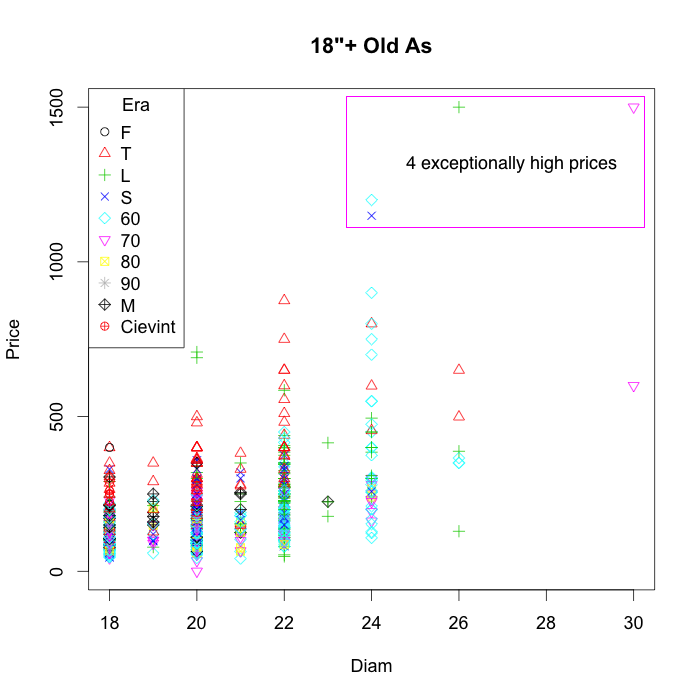
As you get past 22" prices stay pretty much the same. There is a wide distribution of prices, but they don't seem to be going up in price as they get larger. There are 4 sales (this is out of about 900 sales) which are above $1000 and I've enclosed them in a rectangle. They include 2 24" cymbals (one 60s era and one Small Stamp late 50s era), 1 26" Large Stamp cymbal, and 1 30" 70s era cymbal. In all four cases it isn't clear how much they really contribute to the general picture of prices.
These four prices are much higher than most sales. The two 24" cymbal sales were unusually high at around $1200, and one was a Small Stamp and one a 1960s stamp. One explanation I can put forward for the very high prices of these two cymbals is that they sound really good, were relatively light, and were in good condition. They were sold with excellent sound files. Exceptional cymbals and exceptional price. The 30" cymbal was misleadingly advertised as a 1940s cymbal and I'm dubious that it actually sold at that price. I suspect that it may have sold for a much lower value. The 26" Large Stamp (it was a Type I aka Hollow Block) is also an outlier as a sale value. It supposedly sold with 1 bid, but again there are about 11 cases of Large and Small Stamp 26" production era cymbals which were priced at $550 and above and never sold (no bids). I suspect these last two sales are examples of outcome codes on online sales sites which suggest that the item sold at the asking price but that didn't really happen. But we can't be sure.
The other reason for this little diversion from individual diameter analysis is to see if we can make use of the larger sample sizes of 22" and 24" cymbal sales to extrapolate to the expected prices of 23" where there are fewer sales. It looks like this is a reasonable thing to do. The same applies to 19" and 21" cymbals.
A related topic for a little overview is the claim I've seen a couple of times that $10 per inch is a pretty good price estimate for used cymbals. I'm not actually sure whether the proponents of this approach intend this to be reasonable estimate for all brands and all diameters, or Avedis Zildian cymbals over a limited diameter range. As a first look I've repeated the graph above but using price per inch:
Image: 18 inch plus price per inch
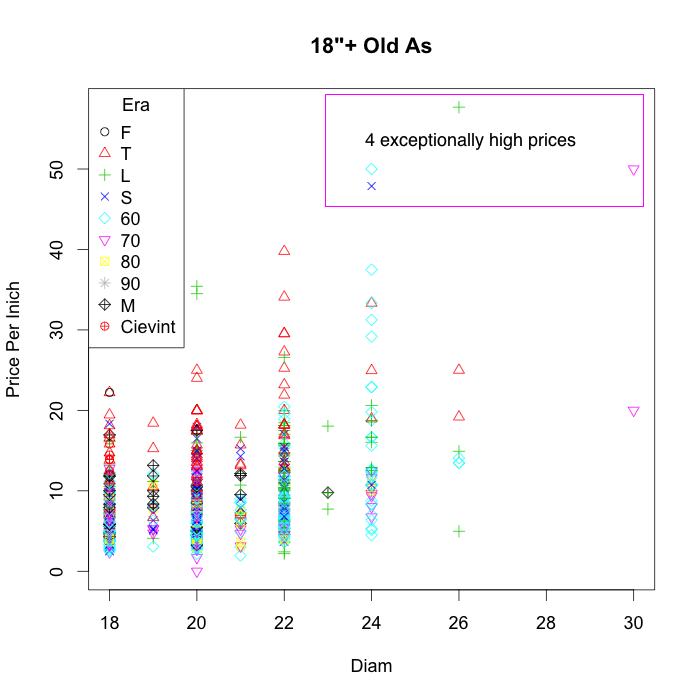
What we see is that $10 per inch works pretty well for used Avedis Zildjian cymbals, but not for Trans Stamps. Trans Stamps look more like $20 per inch would be better. You can see the red triangle of Trans Stamps floating up above the general price distribution. The $10 per inch also wouldn't work for K Zildjian Istanbul cymbals. But it still presents another approach to estimation which I'll be following up.
Analysis date: 28 Apr 2018
Here is an overview of the prices for 22" Avedis Cymbals by Stamp Era.

The above is a plot of prices for 22" cymbals divided by Stamp (Trademark) Era.
After examining the data, I grouped together the three Large Stamps into one category for reporting, although they are separate in the raw data. Similarly, all the Trans Stamps are reported together.
The median expected price for the different eras is:
In terms of statistical significance, there isn't much of a price difference between the 60s and the 70s, or the Small Stamps. Large stamps are little higher in expected value (p<0.05) and Trans Stamps are higher again (p<0.001).
The era of a cymbal predicts about 37% of the price, but there are more variables at play. We now turn to the effect of weight.

This graph shows the relationship between price and weight in grams. There is a significant relationship between price and weight, with lighter cymbals tending to reach higher prices. However, this pattern is confounded by the price which Trans Stamps generally attain. Trans Stamps are both lighter on average and fetch higher prices on average, so it is hard to tease apart what portion of this is due to weights and what is due to being a Trans Stamp.
Weight predicts about 20% of the variation in price on its own. Stamp Era predicts about 37% of price on its own. But note the 20% contribution for weight is not additional to the 37% contribution of stamp era. Fitting a joint model with both stamp era and weight as predictors allows us to see if there is an independent contribution to price from being a Trans Stamp beyond just Trans Stamps being lighter. The joint model shows being a Trans Stamp (p<0.001) and lighter in weight (p<0.001) are both predictors of higher price. So there is a contribution from being a Trans Stamp beyond just being lighter. The joint model explains 47% of the total variation in price.
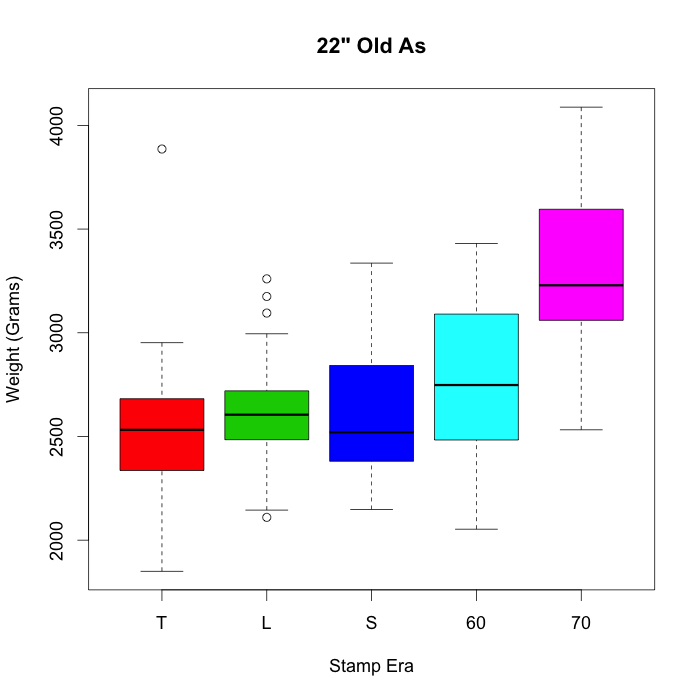
Within any era there are lighter and heavier cymbals, and the distributions overlap a bit. But against this background, there is a general increase in weight across the Stamp Eras. There isn't much in the difference between the three 1950s Stamp Eras, but the 60s jump up a notch, and the 70s jump up even more.

There are no significant price differences between the 4 years in the data. Prices are highly variable but there isn't an overall trend. What seem to be two nearly identical cymbals in terms of Stamp Era, condition, and weight can sell for a $100 difference in price.
Analysis date: 13 Dec 2017
Here is an overview of the prices for 21" Avedis Cymbals by Stamp Era. In this plot we also have samples which are more modern (M for modern) which are post 1994 when Laser Stamps began. Note that even though I've started to include modern cymbals in the analysis, I haven't changed the graph titles so they still stay "Old As". When I started my study I was mainly concerned with "Old As" (as in before 1980) but I've since had my arm twisted to extend my work to include modern cymbals. Since that extension in my focus happened part way through, I don't have as many examples of modern cymbals as I do of 50s cymbals.

The above is a plot of prices for 21" cymbals divided by Stamp (Trademark) Era. After examining the data, I grouped together the three Large Stamps into one category for reporting, although they are separate in the raw data. Similarly, all the Trans Stamps are reported together. Sample sizes for the 21" size are smaller than for the more common 22" and 20" sizes, so all of these come with a "small sample" warning attached.
The median expected price for the different eras is:
One of the effects we're starting to see in this overview is that the 1950s cymbals (T,L,S) get collectable prices, 60s 70s and 80s get lower prices, but as you move into much more recent cymbals prices come back up. The M category is quite a mix of ages but I expect that pattern to be clearer as I focus my sampling on more recently produced cymbals. Part of what seems to be going on is we've moved from old worn cymbals showing their age(favored by one part of the market) to shiny cymbals in excellent condition with all logos intact (favored but a different part of the market). But that's just one potential factor, and the lighter weight of older cymbals (in general) might also be a factor price. The era of a cymbal predicts about 35% of the price on its own. But we can do better at prediction if we also consider weight.

Within any era there are lighter and heavier cymbals, and the distributions overlap a bit. But against this background variation, there is a general increase in weight across the decades. There isn't much in the difference between the three 1950s Stamp Eras, but the 60s jump up a notch, and the 70s jump up even more, and the 80s are heavier again. In the modern era (post 1994) weights have come back down although my modern sample is still small at this point. However, I can foreshadow the sort of thing which may be driving the change. A popular model in the 21" size was the Rock Ride which are heavy beasts. In more modern times another model, the Sweet Ride, is Zildjian's best selling ride. The Sweet Rides come in around 2500g and the Rock Rides above 3000g. The other changes in the wind (and my modern sample) are the 2013 reset of weights, and the new A Avedis series.

This graph shows the relationship between price and weight in grams. There is a significant relationship between price and weight, with lighter cymbals tending to reach higher prices. However, this pattern is confounded by the price which older cymbals generally attain. 1950s cymbals are both lighter on average and fetch higher prices on average, so it is hard to tease apart what portion of this is due to weights and what is due to being older.
Weight predicts about 35% of the variation in price on its own. Stamp Era predicts about 35% of price on its own. But note the 35% contribution for weight is not additional to the 35% contribution of stamp era. The joint model explains 40% of the total variation in price, which suggests there is lots of overlap. In the full model (era and weight) being a Trans Stamp or Small Stamp has the largest positive effect on price, and being a lower weight is still a significant (p<0.05) predictive factor. In simple terms: low weight Trans stamps do best.

There are significant price differences between the 4 years in the data. Prices for 21" cymbals dropped from 2014 to 2015, and then made a partial recovery in 2016 and 2017. But given the relationship between price and weight, and price and production era, the dip in 2015 could actually be due to a different mix of cymbal weights and eras in my 2015 sample. To test this I fitted a linear model which included weight and stamp era as well as year of sale. The effect of year doesn't quite reach significance (p=.1) in this model which suggests the dip is indeed just sample composition. Given that the other diameters don't replicate this market dip, the visible change doesn't seem to be anything other than a slight change in the composition of my sample.
Analysis date: 16 Dec 2017
Here is an overview of the prices for 20" Avedis Cymbals by Stamp Era. Again I use shorter names here because it is better on graphs. In this plot we also have samples which are more modern (M for modern) which are post 1994 when Laser Stamps began. This graph also includes cymbals from the A Zildjian & Cie Vintage series from 2000-2007 and 2010. Note that even though I've started to include modern cymbals in the analysis, I haven't changed the graph titles so they still stay "Old As". When I started my study I was mainly concerned with "Old As" (as in before 1980) but I've since had my arm twisted to extend my work to include modern cymbals. Since that extension in my focus happened part way through, I don't have as many examples of modern cymbals as I do of 50s cymbals.

The above is a plot of prices for 20" cymbals divided by Stamp (Trademark) Era. Once again, I grouped together the three Large Stamps into one category for reporting, although they are separate in the raw data. Similarly, all the Trans Stamps are reported together. Sample sizes for the 20" size are larger than for the less common 21", so I've been able to include more examples of more recent decades.
The median expected price for the different eras is:
One of the effects we're starting to see in this grand overview is that the 1950s cymbals (T,L,S) get collectable prices, 60s to 90s get lower prices, but as you move into much more recent cymbals prices come back up. The M category is quite a mix of ages but I expect that pattern to be clearer as I focus my sampling on more recently produced cymbals. Also, the A Zildjian & Cie Vintage Cymbals seem to get relatively high prices, like the early 1950s cymbals they were designed to emulate. One possibility is that they are sought after because they were a limited production and now discontinued. But that's just one potential factor, and the lighter weight of older cymbals (in general) might also be a factor in price. The era of a cymbal predicts about 37% of the price on its own. But we can do better at prediction if we also consider weight.
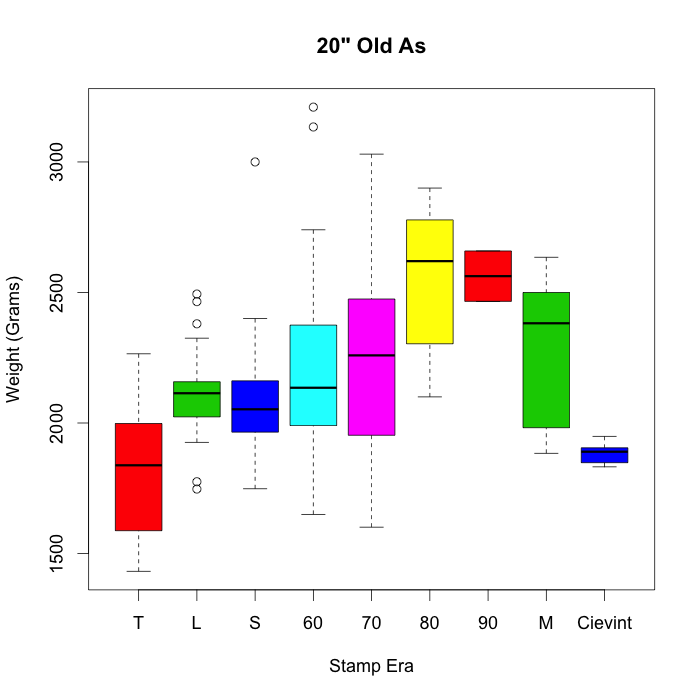
Within any era there are lighter and heavier cymbals, and the distributions overlap a bit. But against this background variation, there is a general increase in weight across the decades. The Trans Stamp Era is lightest, then the weights trend up until the 80s, then they trend down again. The A Zildjian & Cie Vintage 20" rides stand out as their weights are reset back to the Trans Stamps. There is also a 2013 reset of A Zildjian weights, some of which appear in my Modern era sample.

This graph shows the relationship between price and weight in grams. There is a significant relationship between price and weight, with lighter cymbals tending to reach higher prices. However, this pattern is confounded by the price which older cymbals generally attain. Trans Stamp cymbals are both lighter on average and fetch higher prices on average, so it is hard to tease apart what portion of this is due to weights and what is due to being older. For 20" cymbals around $500 is a natural ceiling, although there were 3 individual cymbals which got much higher prices. Two are Large Stamps (unusually light Large Stamps) and one is a light Trans Stamp.
Weight predicts about 23% of the variation in price on its own. Stamp Era predicts about 37% of price on its own. But note the 23% contribution for weight is not additional to the 37% contribution of stamp era. The joint model explains 43% of the total variation in price, which suggests there is lots of overlap. In the full model (era and weight) being a Trans Stamp or Large Stamp has the largest positive effect on price (partly driven by those 3 outlier high prices), and being a lower weight is still a significant (p<0.05) predictive factor. In simple terms: low weight Trans stamps do best, and so do the A Zildjian & Cie Vintage rides.

There are no significant price changes between the 4 years in the data. Given the relationship between price and weight, and price and production era, the variation is just due to a different mix of cymbal weights and eras in different years. Once again you can see the three price outliers (above $500) with one sold in 2015 and two sold in 2016. Using robust fitting methods and statistical tests means these unusually large sales don't have undue influence on the median estimates.
Analysis date: 17 Dec 2017
Here is an overview of the prices for 19" Avedis Cymbals by Stamp Era. In this plot we also have samples which are more modern (M for modern) which are post 1994 when Laser Stamps began. Note that even though I've started to include modern cymbals in the analysis, I haven't changed the graph titles so they still stay "Old As". When I started my study I was mainly concerned with "Old As" (as in before 1980) but I've since had my arm twisted to extend my work to include modern cymbals. Since that extension in my focus happened part way through, I don't have as many examples of modern cymbals as I do of 50s cymbals.
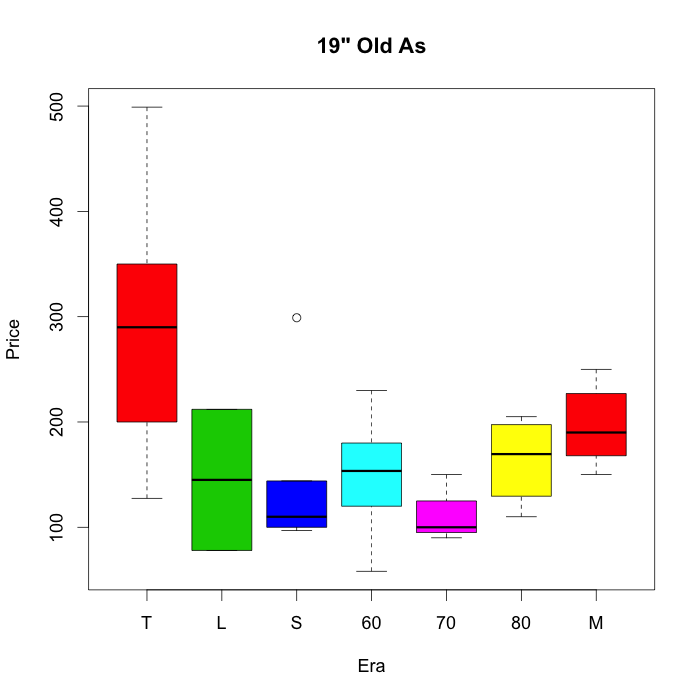
The above is a plot of prices for 19" cymbals divided by Stamp (Trademark) Era. After considering the low sample sizes for 19" cymbals I decided to give just two estimating equations for now. This is guided by the significance testing which shows that with small samples there too much variability to pick up consistent differences. The median expected price for the different eras is:
The Trans Stamp cymbals get higher prices on average, and all the later eras are lower. As you move into much more recent cymbals prices come back up a little. But agin it is early days and small sample when we divide them up into these smaller eras.

Within any era there are lighter and heavier cymbals, and the distributions overlap a bit. But against this background variation the Trans Stamp Era is lightest, then the weights go up until the 90s, then they come back down part way in the Modern (M = laser era) cymbals. Part of the reason for this is the 2013 reset of A Zildjian weights, some of which appear in my Modern era sample.

This graph shows the relationship between price and weight in grams. There is a significant relationship between price and weight, with lighter cymbals tending to reach higher prices. However, given the low sample sizes there isn't really much more to say about the 19" case in particular.

There are no significant price changes between the 4 years in the data. The large bar for 2014 reflects the data collection in the first year of my study when I concentrated on older cymbals (Trans Stamps in particular) and there are two cymbals from 2014. One just happened to be a very high priced Trans Stamp ($499) which was light (1532g) and one 1950s Trans stamp cymbal ($127.50) which was unusually heavy (2000g). The R system has just drawn the box around those two points. I've left this in to show how important it is to get large enough samples so that the estimates settle down. The following three years give a more reasonable view of prices, and show no significant variation between years.
Analysis date: 17 Dec 2017
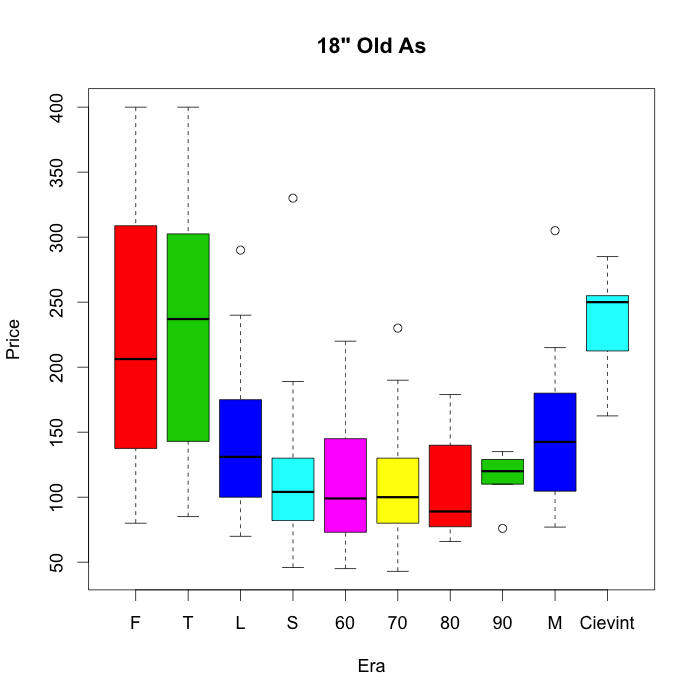
First Stamps, Trans Stamps and A Zildjian and Cie cymbals get higher prices. Stamp Era predicts 28% of the price variation in the model.
The median expected price for the different eras is:
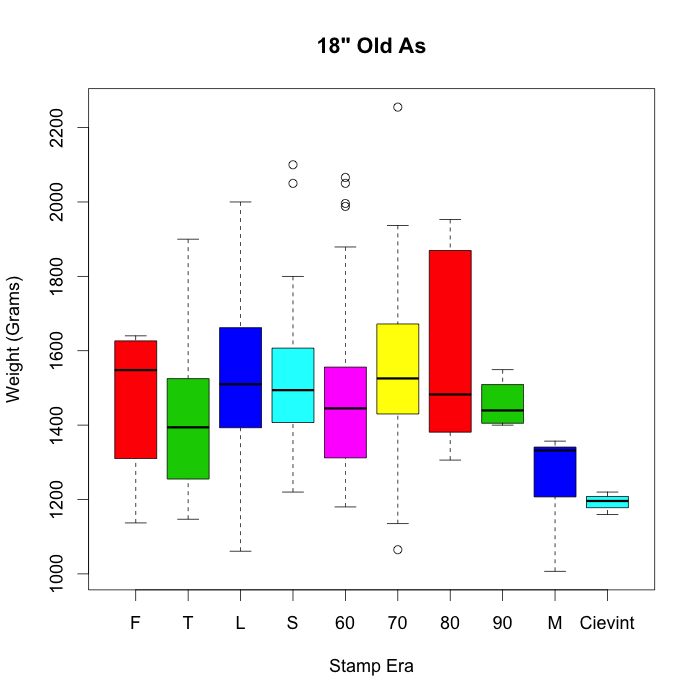
First Stamps, Trans Stamps and A Zildjian and Cie cymbals tend to be a bit lighter than the other eras. We know that A Zildjian and Cie 18" cymbals are thin crashes and their design is based on Trans Stamp cymbals. For most Old As we don't know whether a particular cymbal was designed as a dedicated crash or a ride cymbal, or something like a crash ride. There are a few Old As where model ink has remained intact. For First Stamps and Trans Stamps some may well be ride cymbals back in the days when smaller ride cymbals were in fashion. Sorting out models for Old As, and how this relates to weight, is left as a separate exercise for the future. One cymbal which is excluded from this general analysis is an 18" Second Stamp Swish weighing 1000g which is reputed to have sold for $600. This is one of a few Swish models from the 1940s and their appearance is consistent with the catalog offerings of the day.

In this view you can see that Trans Stamps (and First Stamps) tend to be the ones over on the right side of the graph getting the high prices (over $350). However there is one Small Stamp at around 1400g which got well over $300.
The other thing visible in this graph is that there are a group of 18" cymbals which are 1700g and above over on the top left side. These are your heavier 18" cymbals and they were probably intended as ride cymbals or for marching band use. But the majority of the 18" Old As fall in the 1200g to 1600g range.
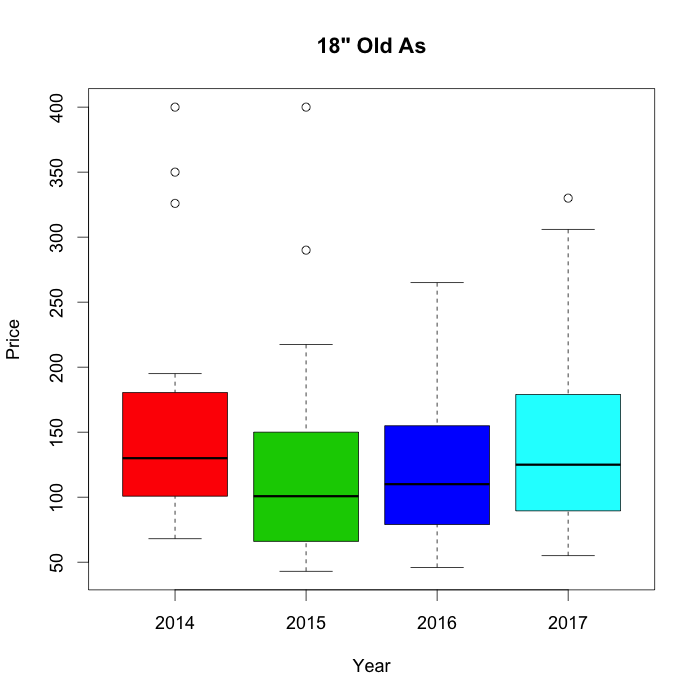
There is no evidence for any price difference between 2014 and 2017. What does appear again in this view is that there are 8 sales which are higher value outliers and are significantly higher than the general price distribution. These happen occasionally, and in each of the four years.
Analysis date: 24 Dec 2017

Trans Stamps get higher prices, and Large, Small, and 60s Stamp cymbals get lower prices. There is a slight price recovery in cymbals from the 70s and later. Stamp Era predicts 20% of the price variation in the model.
The median expected price for the different eras when you have no idea about the weight:
In a model with just weight, this predicts 18% of price, so weight does matter. A joint model with both Weight and Stamp era predicts 40% of price, showing that there is predictive value in a joint pricing model.
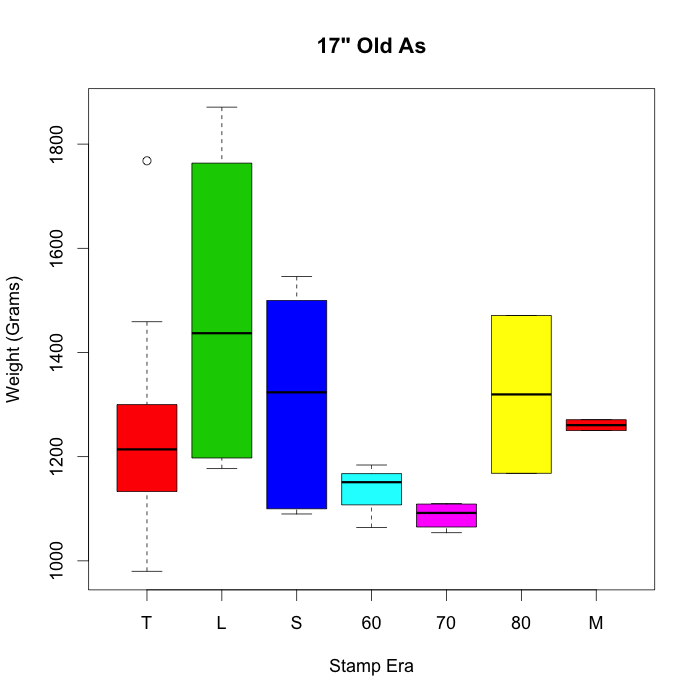
Weights for Trans Stamps are lower than Large and Small stamps (some very light), but in the 60s and 70s era the median weight is actually lower than Trans Stamps. It looks as if I've got mostly Crash cymbals in my sample for 60s and 70s cymbals, and probably Thin Crashes at that. In the mid and earlier 1950s 17" ride cymbals were more popular so this might explain the heavier weights.
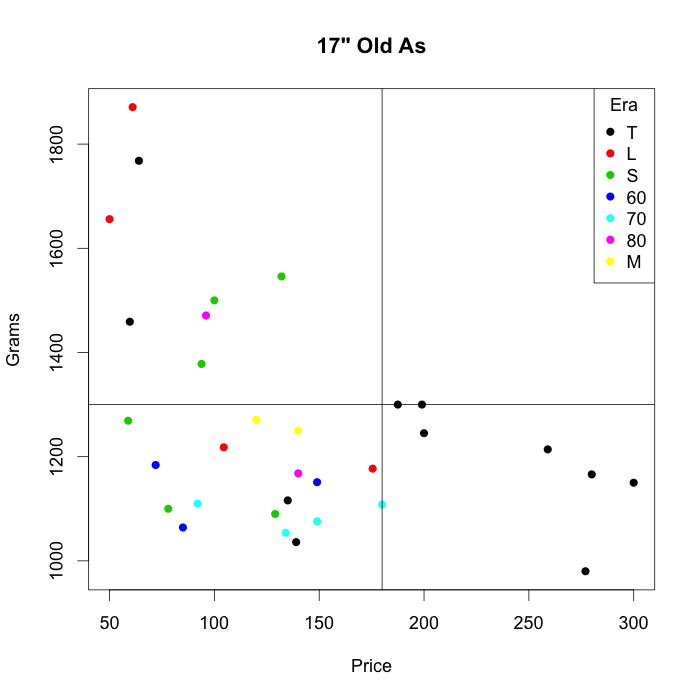
In this view you can see that Trans Stamps are the ones over on the right side of the graph getting the higher prices (over $180). Some Trans Stamps get over $180, but not all of them. The difference is down to weight. You can see that 4 Trans Stamp cymbals sold for under $180, but the two lowest prices are for those over 1450g. Joining them in the upper left quadrant (heavier and lower price) are two Large Stamps and three Small Stamps plus one cymbal from the 1980s. With the exception of one Small Stamp these heavier cymbals are go for prices of $100 or below.
The most populated quadrant is the lower left, and this contains all the 60s and 70s cymbals and the two Modern ones. The Large Stamps and Small Stamps straddle the two quadrants above and below 1300g.
When you know both the weight and the production era the expected prices are:

There is no evidence for any significant price difference between 2014 and 2017. It looks as if prices are dropping slightly ($50), but once you extract the variation due to stamp era and weight, there isn't any real difference to be seen beyond the background level of price variability from one sale to the next. Prices are just bouncing around.
Analysis date: 26 Dec 2017
unknown era orchestral pair $57 (very poorly documented)
60s 1020g 1417g $125
70s 1100g 1400g $175 ink: TOP HI-HAT
70s 1730g 1810g marching band $200
60s 1080g 1153g $215
Small Stamp 816g 906g $232.50 ink: TOP HI-HAT
Trans Stamp 970g 982g $338
First Stamp 887g 1077g $545
Given the tiny sample there isn't much more to say about variation in weights or prices separated by production era. So we'll move on the single cymbals for now.
Here is an overview of the prices for single 16" Avedis Cymbals by Stamp Era. In this plot one Large stamp has been recoded as a Trans stamp (T) because there was only one.

There isn't that much variation in price which is predicted by Stamp Era. Trans Stamps and Small Stamps get slightly higher prices. But Stamp Era predicts only 7% of the price variation in the model. This is different from 18" and larger cymbals where stamp era is the biggest factor. So you should use the following predictions only when you don't know anything about weight. If you do know the weight then see further down in this section.
The median expected price for the different eras when you have no idea about the weight:
In a model with just weight, this predicts 21% of price, so it does much better than just Stamp Era on its own. A joint model with both Weight and Stamp era predicts 34% of price, showing that there is predictive value in a joint pricing model.

Weights for Trans Stamps overlap completely with post Trans Stamps, but also go down below 900g and all the way down to 720g. But there are also a few heavier Trans Stamps (up to 1760g) as well. This shows it isn't a good idea to simply assume all Trans Stamps are light. And the results so far suggest we need to take a closer look at the interaction of production era and weight.

In this view you can see that Trans Stamps and First Stamps tend to be the ones over on the right side of the graph getting the higher prices (over $150). There are two Small Stamps which made it into that price band as well. So basically 1950s (and older) cymbals can get over $150, while 60s and later ones do not.
The other thing visible in this graph is that there are a group of 16" cymbals which weigh 1100g and above on the top left side. With one exception (a Trans Stamp) 16" cymbals above 1100g do not get prices above that $150 line, even when they are of the older production eras which tend to get get higher prices. Then there are a few cymbals which weigh above 1600g which are your heavy 16" cymbals and they were probably intended as ride cymbals or for marching band use.
When you know the weight of a 16" cymbal but nothing of the production era the expected prices are:

There is no evidence for any significant price difference between 2014 and 2017. It looks as if prices are dropping slightly ($30), but once you extract the variation due to stamp era and weight, there isn't any real difference to be seen beyond the background level of price variability from one sale to the next.
Analysis date: 25 Dec 2017
15" Pairs
15" Singles
As far as weights for pairs go, during the Trans Stamp era (and earlier) most pairs are matched (approximately equal in weight). But just because they are matched doesn't automatically imply very light, although most Trans Stamps (all labelled 40s in the graph) are light compared to other eras.
Image: 15" A Zildjian weights by era

In this plot, a diagonal line going from lower left to upper right is your "matched pairs" where the top and bottom are nearly equal in weight. The points which fall over to the right of that "matched pairs" line represent the heavier bottom which we now know as "New Beat" ratio. If you have a look at the black points there are two matched pairs of Trans Stamps at around 1200g each, and two more up at 1400g each. These are most likely "band" or "orchestral" pairs. The same cutoff of about 1200g works for the 1950s (red dots), although there is only one pair of matched at about 1400g. The other 1950s pairs with a heavier bottom aren't New Beats sold as New Beats (they came later in the 1960s) but people were starting to pair them up like that presumably using a "band" or "orchestra" cymbal on the bottom.
By the 1960s the New Beat ratio is starting to be much more common, and in the 70s and 80s there are more of those than there are matched pairs. Yes there are a few heavy 15" matched pairs (presumably band/orchestral) in the 70s and 80s. But the bigger picture is the advent of the New Beat style heavier bottom which comes to dominate the lower right portion of the graph as the decades roll forward.
A brief note on labels: I haven't got enough to separate First/Second and Trans. In this graph 40s = First, Second, Trans combined; 50s = Large + Small. As we know Trans aren't all 40s, and First are 30s, but it seems a good simplification for summary purposes. For the 50s category Large stamps are combined with Small because as we also know, there are very few Large stamps with diameters as small as 15". Large by Stamp and Large by Diameter. So the 50s category is dominated by late 50s Small Stamp cymbals. I may come back and change the label convention to me more like other diameters, but I was experimenting with how this way of doing it would work where everything is in decades rather than some letters and some decades.
Analysis date: 2 Nov 2017
Image: 14" A Zildjian Hi Hat Pairs by Era

The prices are higher for Trans Stamp (and First Stamp) pairs, then lower in the late 50s, and lower again in the 60s to 80s. Note that I haven't got any Large Stamp 14" hats in my sample. These are known to exist, but are relatively rare. If pushed to price them, I'd use the Trans Stamp predictions. Although I know of maybe 4-5 pair, I haven't recorded any sales. The sample for modern (post 1994) cymbals is small and you shouldn't read too much into the median price seeming to go up again. This might just be due to some nearly new cymbals included in my sample. So I haven't given a prediction for post 80s hats until I clarify the situation and get more examples.
14" Pairs
This analysis includes New Beats as well as Matched hats (top and bottom within 100g of one another). New Beats came on the scene during the 1960s, so earlier hat pairings aren't "officially" New Beats, although they can still be pairs with a heavier bottom as we will see. For full info on New Beats see The New Beats page.
Image: 14" A Zildjian Hi Hat Pair Weights

Looking at the top vs bottom weights for pairs we can see the increase on weights over the production eras, and we can also see the coming of the New Beats from the 1960s on. The lines going from lower left to upper right are 100g apart and the top line is set at top weight equals bottom weight. The pairings well below the lower line (and on the right) are the New Beat ratio hats.
There are a few unusual pairings here which deserve special mention. They are circled in the plot. The first is the very light matched 1960s pair in the lower left corner. This turns out to be a pair of a likely 1954 Stamp hats (502g and 507g) with TOP HI-HAT ink intact. These were coded for this analysis as 1960, although the full information is retained in the raw data. The seller didn't know they were from the mid 1950s, and the price was closer to a 60s price than a Trans Stamp price. I may change the classification of this pair to Trans and redo the analysis, but I've left them as is for now. Because I use robust estimation techniques one or two cymbals changing classification does not change the price estimates.
The second circle marks two pairs (one 60s one Trans Stamp) which are very light but down in the zone of New Beat ratio. The Trans Stamp pairing (540g over 980g) is well before New Beats began. It turns out to be a Second Stamp paired with a Zilco TM Stamp but appears under Trans Stamps in this analysis because I've combined it into that era since I don't have enough Second or Zilco TM to separate them out.
The 60s pair very close to the mixed stamp pair were misidentified as 1970s by the seller but as far as I can tell the bottom was a 60s and the top might be 50s. They weren't very well documented and seeing those weights plotted with all the other pairs makes me think the top was earlier. I usually get all these classification details (it's called data cleaning) sorted out before I report any analysis but in this case I decided that it gives you some insight into the process.
Image: 14" A Zildjian Hi Hat Pairs Top Weight by Era
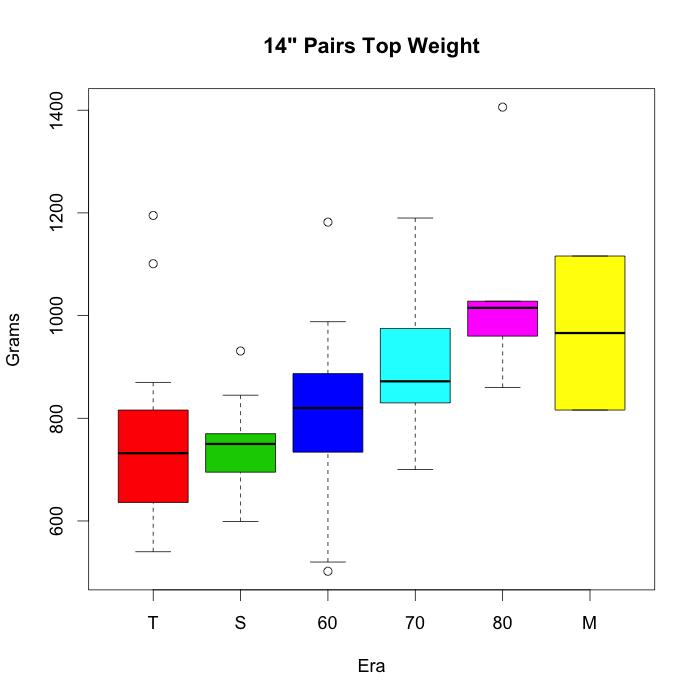
This plot is another way to see the overall rise in weights over the decades. The rise is easier to see because we're just looking at top weights. Bottom weights show a similar trend but the pattern is different in detail because of New Beat weight bottoms coming into use. The special case 1960s very light hats discussed previously remain visible in the long lower whisker and outside value (open circle) seen in this plot. The one very light mixed pair (coded Trans Stamp) also are reflected in the long lower whisker. The outlier values at the upper end of the weight scale (2 x Trans, 1 x Small Stamp, 1 x 60s, 1 x 80s) are all likely to be marching band pairs. And once again, the Modern (M) category is small thus not well estimated (large bar) so it is best to not pay too much attention to that result for now. Modern (and often 80s and 90s) cymbals tend to have their model ink intact and deserve their own analysis by specific model.
Image: 14" A Zildjian Hi Hat Pairs Price by Year

There is no evidence of a shift in prices of Hi Hat Pairs across the years 2014-2017. Once again, lots of variation but no detectable shift in median prices.
Image: 14" Single Old A Prices

There are really only three price groups represented here: pre 1960s, post 1950s, and a special close grouping for cymbals from the A Zildjian & Cie Vintage series from 2000-2007 and 2010. As with the 20" results for the A Zildjian & Cie Vintage, the 14" are fairly uniform in price and weight. In terms of price the 14" A Zildjian & Cie Vintage go for higher prices then the pre 1960s cymbals. In terms of individual production eras, the price estimation is
14" Single Prices
The situation in terms of weights is not quite the pattern I expected based on other diameters.
Image: 14" Single Old A Weights

The pre 1960s cymbals are usually lower weight as expected. The post 1950s cymbals are usually heavier weight as expected. But the Modern cymbals are closer to pre 1960s weights, and the A Zildjian & Cie Vintage are in the post 1950s weight range. But unlike larger diameters where price is predicted by weight, in this case of 14" singles there is no such relationship.
Image: 14" Single Old A Price by Grams

What shows up clearly instead is that there are two groups of single cymbals: 800g and under, versus 1100g and over. These probably correspond to lighter hat tops and thin crashes, versus hat bottoms or more robust cymbals. But a heavier cymbal can get as high a price as a lighter one. The two A Zildjian & Cie Vintage cymbals plotted in the upper section did have model ink saying Hi Hat Bottom. There were two other A Ziljdian & Cie Vintage Crashes (with model ink) which don't appear in the weight plot because weights were not supplied -- just selling price. This explains the unexpected behavior of the A Zildjian & Cie Vintage prices and weights. I actually have the expected range for A Zildjian & Cie Vintage hi hat tops from my other (non price study) sources and the expected range is 722g through 850g. Despite the design specs for these being Trans Stamps, Zildjian chose to have them weighted more like New Beats. Clearly the design was a winner and these hats fetch good prices.
As with the 14" pairs, the single 14" cymbals show no overall change in prices across the years 2014-2017.
Analysis date: 2 Jan 2018

There are two groups of hat pairs, separated by a gap. There are very light matched pairs (below 600g) and there are heavier pairs with a light top and heavier bottom. The very light matched pairs are 1950s. The heavier pairs include a few First Stamps, as well as post 1950s cymbals. The one labelled 6T is a home made pairing of a light Trans Stamp top with a heavier 1960s bottom.
Because my sample sizes are small, I'm not really able to provide production era specific pricing info. So all we have for now is the price distribution for 13" pairs:
Analysis date: 2 Jan 2018

There are two groups of hat pairs, as there were with 13" pairs. There are the very light pairs (below 500g) and there are two heavier pairs. The very light matched pairs are 1950s. The heavier pairs include a matched Trans Stamp pair, as well as the one 1960s pair. The 1960s pair is a ligther top with a heavier bottom.
Because my sample sizes are small, I'm not really able to provide production era specific pricing info. So all we have for now is the price distribution for 12" pairs:
For single 12" cymbals there are 21 completed sales. One of these is 1960s, one is 1980s and the rest are 1950s or older. This is not because 12" cymbals stopped in the 1960s. It is because I was specifically looking at older cymbals when I was sorting out Trademark examples. In the future I will be using a new data sampling scheme which will help fill out the picture. In the meantime all we have is the price distribution for 12" singles:
Weights for these smaller diameters are
Analysis date: 2 Jan 2018
or back to the introduction page
text stabilized 25 Feb 2016 3:41 PM
text last updated 28 Apr 2018 6:00 PM

This work is licensed under a Creative Commons Attribution-ShareAlike 4.0 International License.